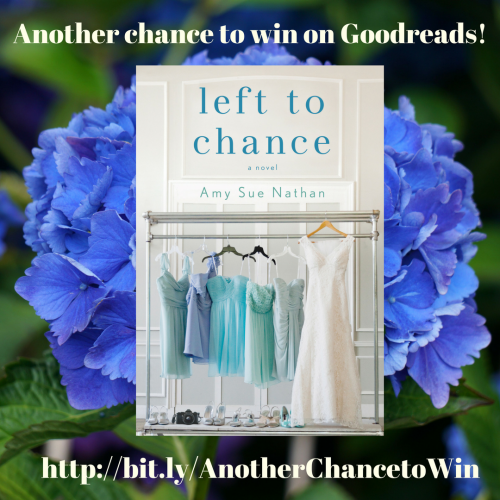Amy Sue Nathan's Blog: Women's Fiction Writers, page 10
August 10, 2017
GIVEAWAY WINNERS ANNOUNCED!
CONNIE BELLO-CARPENTER
CAROL SIGLE DOSCHER
CONGRATULATIONS!
Please email your snail mail address to amysuenathan @ gmail dot com. Use the subject line: I won!
Didn’t win? There’s a Goodreads giveaway! Check it out!

August 4, 2017
Win an early copy of LEFT TO CHANCE!

I’m heading out-of-town but with the magic of the the blogosphere here are several ways to enter another giveaway for Left to Chance! I’ll announce the winner when I’m back from my trip next week — so watch the blog and social media! — Amy xo
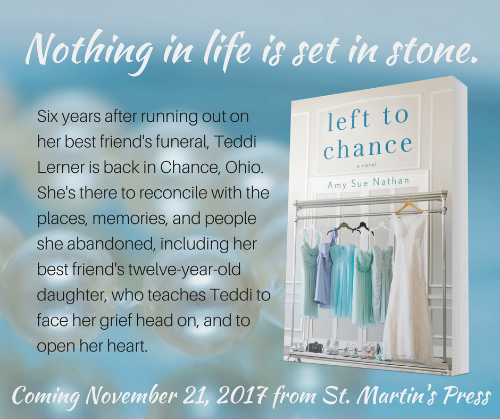
July 30, 2017
How Long Does It Take To Write A Novel?
 A few weeks ago when I was chatting with my agent, we realized it had taken nine months to get from concept to proposal for my fourth novel.
A few weeks ago when I was chatting with my agent, we realized it had taken nine months to get from concept to proposal for my fourth novel.
NINE MONTHS. LIKE THE TIME IT TAKES TO GROW AN ACTUAL HUMAN.
Granted, in that time, I had sold and packed-up a four-bedroom house and moved cross-country, all while parenting my adult children through some milestones in their lives. I was also in the final editing stages with my publisher for LEFT TO CHANCE, and if you somehow missed it, that novel will be published in November. I also moved into my very first apartment (at age 52) and hit reset on many things me.
It’s no wonder then, perhaps, that finding the story and the voice took longer than I ever could have imagined.
I did have the luxury of no contract (looking on the bright side) and no deadline. THE GOOD NEIGHBOR and LEFT TO CHANCE both took me about a year to write, while THE GLASS WIVES took about three years. TGN and LTC were written under contract, and that lend a legal urgency to things. While I hope to be writing the rest of THE LAST BATHING BEAUTY under contract as well, I can rest easy knowing that the character and story development took shape in its own time, because it could. I now have about 60 pages of THE LAST BATHING BEAUTY and give myself about a year to write the rest, whether on deadline or not.
I have friends under contract who need much less time to write their novels, and who publish at a much quicker pace than me. I seem to be birthing a book every two years, and I suspect (hope) THE LAST BATHING BEAUTY will be out for summer 2019, keeping me on track with that. Some authors have a book or two a year. Romance authors write even more. I have friends who spend two to five years writing books, even under contract.
Writing a book takes as long as it takes.
Even under contract, the amount of time varies. Does writing a book in a year mean 40 hours per week (HA) with weekends off (what is this weekends off people speak of)? For me it might mean two days of 12 hours of writing and then no writing for three days. I have never counted hours and I don’t count words — I write the number of scenes I need in the time it takes to write them.
I know I’m fortunate. I don’t have a day job and I don’t have carpool or kiddos. I do have freelance work that figures in, and while it’s not pulling on my pant leg when I go to the bathroom and I can do it on a Sunday morning, it is still brain time away from my own book.
When I’m finished compiling more historical info for TLBB, I’m going to get back to writing. It’s the first time I have an idea of how much I need to write in a prescribed amount of time. 25 chapters by March, when I will show the finished book to my agent and she’ll give me awesome feedback (it’s what she does) and I’ll revise to have a polished draft by June. Which will mean that, from a strictly writing standpoint, it will have taken me about a year. Since this is the longest and most complex book I’ve undertaken, tacking two timelines, I’m gearing up for the challenge. And the fact that I’m approaching this novel differently, is going to make it a smoother process. Note: I did not say an easier process. I doing think anything about writing a novel is easy, but I do think that having incorporated many tenets from Story Genius (by Lisa Cron) I am encountering many fewer surprises in the motivation of my protagonist. This doesn’t mean I know exactly what she’ll do, but it does mean that I know WHY she is doing whatever it is she does. This is a switch for me. And I love it. (I also alway use Donald Maass books, and that hasn’t changed.)
How long does it take you to write a novel, writer pals? Is it faster or slower than you would have expected? Any tips besides DO NOT TURN ON THE TELEVISION? (I am quite easily distracted.)
Below is a sneak peek at some of my historical South Haven inspiration. I’ll be there in just 8 days!
More soon!
Amy xo
Click to view slideshow.
July 24, 2017
Summer blog update, giveaway links, and a quiz!
It’s summer and the livin’ is easy, right? And the blogging is slow.
After eleven years of blogging I’ve found that traffic drops off more in the summer than it does around the holidays. For those first years I continued with a normal schedule. Then I realized I’d rather enjoy the weather and my extra time, and kick things into gear again in the Fall.
So, blogging aside, this has been a busy month. I’ve polished my submission to a shine and it’s off with my editor, my daughter and her girlfriend were here visiting for eight days, and I’m working my tush off on ideas to promote LEFT TO CHANCE while simultaneously staying on everyone’s good side. I hope.
And today, this is what I came up with:
If you’ve read an early copy of Left to Chance, how fun is this? If you haven’t read it yet, HOW FUN IS THIS ANYWAY?
And did you know there’s a Goodreads Giveaway of 100 copies ending tomorrow? And that I keep giving away copies on BLOOM? If you’re not yet part of BLOOM, it’s super fun and even in summer, it has not slowed down. Fabulous Facebook Groups are the new pink. Which is the new black. Or was.
Back to writing…
For those of you who remember Boop, my main character from my now-submitted WIP, I’m heading to South Haven, Michigan for more research in early August, so I’ll check in from there.
Here’s a sneak peek at a bit of inspiration for The Last Bathing Beauty! Can you imagine teenager today dressed like that at an arcade. Wait. Are there arcades? Kids today! Do they even know what an arcade is? And I don’t mean Chuck E. Cheese.
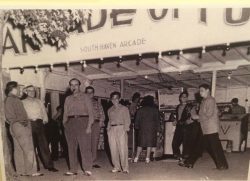
I also have a blog post percolating on just how long novels need to be, as well as some great interviews lined up for Fall — and, the countdown to Left to Chance, which is getting some lovely buzz already!
More soon,
Amy xo
June 13, 2017
Title Talk and a Giveaway
First things first — there’s a new, short giveaway on Goodreads for 75 copies of Left to Chance!
Go forth and enter!
CLICK HERE IT’S EASY GO AHEAD DON’T WAIT
Second, I was going to talk about titles today and this gives me the perfect opening to do so. Why? Because puns. Because Left to Chance gives me endless CHANCES to use the title in everyday ridiculousness, which makes the business of early book promotion a little more palatable, and a lot more fun.
Did you know that all three of the titles of my novels have something in common? The Glass Wives, The Good Neighbor, Left to Chance? Know what it is? This isn’t a quiz show, and there’s already a prize, so I’ll tell you.
The titles are all plays on words. And what’s more fun for a writer than word play?
The Glass Wives is a literal title — with a subtle meaning. Glass is the last name of two women in the story who were married to the same man. So they are, indeed, the Glass wives. There’s also a meaning that evokes the feeling of fragility. I don’t believe the protagonist, Evie, is fragile, but her life circumstances are precarious. Both meanings work for the story. That title is my all time favorite.
The Good Neighbor is about, in addition to other things, two neighbors. ON GOOD STREET! That is why The Good Neighbor works as a title. I don’t think any reviewer, and few readers picked up on the real meaning of the title, especially since there has been discussion as to whether Izzy Lane or Mrs. Feldman were “the” good neighbor, or the titular character, as one reviewer called Mrs. Feldman. NOT. The real answer is BOTH of them are because they live next door to one another. Again. On Good Street.
Left to Chance has meaning of its own which certainly holds true for the story. Teddi Lerner ran away during her best friend’s funeral and returns home six years later after being mostly incommunicado. She has, indeed, left her relationships up to chance in the way that we think of that phrase. Oh, where is THERE, you ask? CHANCE, OHIO. A fictional town created just for this novel. So Teddi does leave everything to Chance — Chance, Ohio. It’s the place she ran away from and the place that allows her to finally heal and move forward. The town of Chance, Ohio is an important character in this book.
The title of the book I’m working on now, The Last Bathing Beauty, isn’t a play on words. But it does have a lot of meaning for the story, so I’m hoping that I can get over the loss of the word play. Considering this book is offering me challenges and joys beyond my wildest expectations, I think I will.
If you’re read the novels I’ve written, were you aware of the word play in the titles? Did you enter the giveaway? If you’ve read any of my books, please sprinkle reader pixie dust on it (and me) if you liked it and add a review to Goodreads and Amazon!
Amy xo
June 7, 2017
When Writing a Novel is like Grilling a Steak
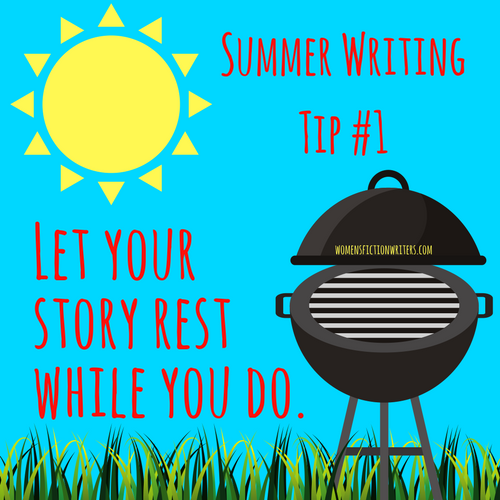
Vegetarian here, but I couldn’t think of a better metaphor for where I am in the writing process than steak. I watch those cooking shows, and I ate meat until 4 years ago. (I’m also not a militant vegetarian. If you want to eat dead animals, have at it. 
May 25, 2017
Author Interview: Author Sonja Yoerg Is Certain of One Thing: The Creative Process is Full of Uncertainty
You know one of my favorite perks of being an author is reading books early, especially when they’re WONDERFUL! I read ALL THE BEST PEOPLE by Sonja Yoerg, and here’s what I had to say about it:
In All the Best People, Sonja Yoerg has crafted a family landscape that is as familiar as it is provocative. With Yoerg’s lush and moving prose, the characters are realistic and bold, yet so compassionately portrayed that I fell in love with even the most unlikable ones. The stories of Carole, the mother who fears she is losing her mind; Solange, the grandmother who already has; Janine, the narcissistic sister who makes bad decisions; and Alison, the little girl who just wants to love from a mother she fears has none to give, are woven together seamlessly to create a story about trust, love, and strength set against a backdrop of 1930s to 1970s Vermont. This book will stay with you long after you read the last page.
You’ll love this interview with Sonja. She has a giving nature and she’s a straight shooter — my favorite combo!
Please welcome Sonja and congratulate her on ALL THE BEST PEOPLE!
Amy xo
Author Sonja Yoerg Is Certain of One Thing: The Creative Process is Full of Uncertainty
Amy: How did the idea spark for ALL THE BEST PEOPLE?
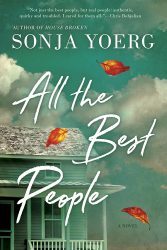 Sonja: For me, the spark for a new book always comes from a character, in this case, eleven-year-old Alison. Eleven is such a fascinating age, on the cusp of adolescence and yet still very much a child. I remember being that age myself, how I began questioning the truths fed to me by my parents, how I realized the world was much more complex than I had ever imagined. It was a thrilling feeling, and a frightening one, and it seemed to me that a large part of who someone ultimately becomes is determined by how they react and change at this point in their development.
Sonja: For me, the spark for a new book always comes from a character, in this case, eleven-year-old Alison. Eleven is such a fascinating age, on the cusp of adolescence and yet still very much a child. I remember being that age myself, how I began questioning the truths fed to me by my parents, how I realized the world was much more complex than I had ever imagined. It was a thrilling feeling, and a frightening one, and it seemed to me that a large part of who someone ultimately becomes is determined by how they react and change at this point in their development.
I wanted to feel close to Alison, so I made her my age and set the beginning of the story in 1972. I’ll do the math for you; I’m 57, which means when I write about my childhood, it’s practically historical fiction!
Amy: I love the idea of books that must be set in a particular place, instead of any place. How did you choose Vermont for the setting for this novel? Do you think the story could have taken place anywhere else?
Sonja: I’m in complete agreement with you, Amy, on the importance of setting. I was lucky enough to grow up in Vermont, and its natural beauty and rustic charm are imprinted on my heart forever. When my husband and I left California a few years ago, we considered moving to Vermont. We didn’t relish the idea of those long winters, however, so aimed further south, ending up in the mountains of Virginia which, funny enough, look a lot like Vermont.
The character, Alison, was a Vermonter from her first appearance in my imagination. It is the childhood I know best, of course, but equally important were the deeper themes that would eventually come to light in the story: the impact of mental illness on families and the legacy of deep-rooted class conflict in Vermont. Although the concept for All the Best People began with Alison, her mother, Carole, is the main character and the pivot point for these themes. As the story begins, Carole’s thoughts are disturbed and she is hearing voices, but she hides these symptoms because she fears ending up like her mother who has been locked up in a mental hospital for thirty-four years. Carole’s mother was of French-Canadian Catholic heritage and poor, while her father was part of Burlington’s Protestant elite and rubbed shoulders with the proponents of Vermont’s eugenics program in the early 1900s. The contrast of Vermont’s magical beauty with this difficult, even shameful, history forms the scaffolding of the story. Of course, the family relationships are the story’s heart.
Amy: There are four POV and two timelines (1920-1950 and 1972) in your novel, so here’s the inevitable question. HOW did you write it? The way we’re reading it? Or did you write timelines and POV separately?
Sonja: The evolution of the structure of this book, if mapped visually, would look like the tracks of a demented squirrel with a vestibular infection. As I mentioned, I started with Alison and entire chapters from her point-of-view were abandoned to the cutting room floor. Carole’s perspective came next, becoming larger and larger as I sought to comprehend her illness and how it figured into her personal story. That led me to her mother, Solange, with her own point-of-view, and that’s when the linear structure I had been developing blew up completely. Solange’s story, her love story and the side trip into Vermont history, the eugenics movement and the treatment of the mentally ill, grew so large it became an entity. I stood back and realized I needed to divide the book into sections: Parts I and III set in 1972 and Part II, Solange’s story and Carole’s childhood. I don’t recall when I added the fourth point-of-view, that of Janine, Carole’s sister. It felt necessary, given how the story had shifted from mostly Alison’s to mostly Carole’s.
I am an extremely organized person so believe me when I say that this process was unnerving at times. I often felt I’d never understand what this book was meant to be about. In the end, however (actually, a long time before I reached the end), I did understand, and it fell together in a way that satisfied me completely. What a journey!
Amy: Before the editing process began for you at Berkeley, how many months (years?) did it take for you to write this book? Was this a usual timeline for you, similar to your other books?
Sonja: The complete draft took about a year to write. It felt like five. I’m lucky that I don’t have to work another job in order to write and my nest is empty—no excuses for me! I write fairly polished drafts, so the manuscript was finalized three months after I finished the draft. Each successive book seems to take me longer to write, so a year was my new record.
Amy: Can you share with us what you’re working on now?
Sonja: I’m in between projects, a very strange and uncomfortable place for me. I submitted my next book, We Have No Title Yet, to my editor several weeks ago and now it is done and dusted! The story is about a modern mom, Suzanne, who, like many moms, has no white space in her planner. She finds a girl by the side of the road, a girl who has lived in the woods her entire life with her family but without contact with civilization. Suzanne rescues the girl but, as the story unfolds, perhaps it is Suzanne who is in need of rescue. The book will be released during the summer of 2018.
I will get going on a fresh page soon—right after I come home from my book tour the next couple weeks. I have a couple of ideas…
Amy: What’s some unconventional or surprising advice you would share with aspiring authors of women’s fiction?
Sonja: Don’t expect what you learn about one project to apply to the next. In my experience, the only certainty about the creative process is the lack of certainty, and what seemed like the perfect approach to the last book might be an abject failure for the next. It might be that I haven’t written enough books to see an overarching pattern in the process, something I can grab onto for the next book. Who knows? For now, the upside is that I’m unlikely to get bored since I never know exactly what I’m going to do next or how I’m going to do it. Stay tuned!
Thanks so much for spending some time with me, Amy. It’s always so fun to chat. And I’m excited for November and the release of your next book, Left for Chance! xo Sonja
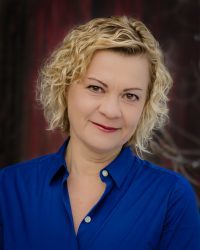 Sonja Yoerg grew up in Stowe, Vermont, where she financed her college education by waitressing at the Trapp Family Lodge. She earned a Ph.D. in biological psychology from the University of California, Berkeley and wrote a nonfiction book about animal intelligence, Clever as a Fox (Bloomsbury USA, 2001). Her novels, House Broken (2015), Middle of Somewhere (2015), and All the Best People (2017), are published by Penguin/Berkley. Sonja lives with her husband in the Blue Ridge Mountains of Virginia.
Sonja Yoerg grew up in Stowe, Vermont, where she financed her college education by waitressing at the Trapp Family Lodge. She earned a Ph.D. in biological psychology from the University of California, Berkeley and wrote a nonfiction book about animal intelligence, Clever as a Fox (Bloomsbury USA, 2001). Her novels, House Broken (2015), Middle of Somewhere (2015), and All the Best People (2017), are published by Penguin/Berkley. Sonja lives with her husband in the Blue Ridge Mountains of Virginia.
website: http://www.sonjayoerg.com/
Facebook: http://www.sonjayoerg.com/
Twitter: https://twitter.com/SonjaYoerg
Instagram: https://www.instagram.com/sonjayoerg/
Amazon: https://www.amazon.com/All-Best-People-Sonja-Yoerg/dp/0399583491
May 24, 2017
Another Reason Blogging Matters
You know those Facebook memory reminders the social media site gifts us on a daily basis? I like looking at the photos to see what was important to me last year or the year before that. I enjoy reading the content of my posts to see what I thought was funny, or worthy.
But today’s FB memory was a link, right to this blog. Six years ago, I — well I’ll let you read it. I was agented but not yet published. I never used the term “women’s fiction novel” (pet peeve, always). I walked the blog readers, possibly some of you, through what I was going through at the moment, and that’s what I try to continue to do here on WFW. Sometimes I’m around less frequently than I’d like to be, but it doesn’t mean I’m not thinking about blogging fodder, or books to review, or authors to interview.
I was surprised at what I read in this post: The Devil Wore Spandex. I’d forgotten most of it. And in that moment I realized I’d forgotten that this blog is for me as much as it is for you. It chronicles my writing life, which, lets face it, is most of my life.
Which is why I’m also thrilled to announce (though you’ve likely already heard), the Women’s Fiction Writers blog has been named one of Writer’s Digest’s 101 Best Websites for Writers for the third year in a row!
Thank you for helping me keep it going, for giving me a reason to keep coming back!
Amy xo
PS I’ll be on two panels at the Writer’s Digest Conference in New York in August! Let me know if you’ll be there too!
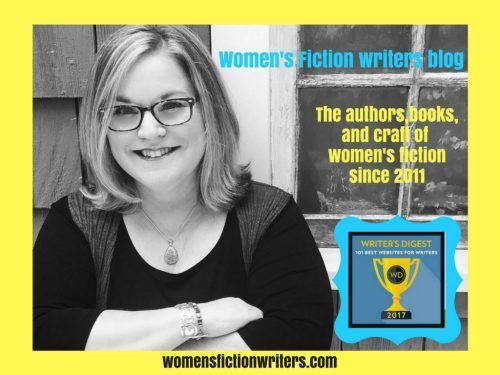
May 16, 2017
4 Tips for Changing POV and Tense in your WIP
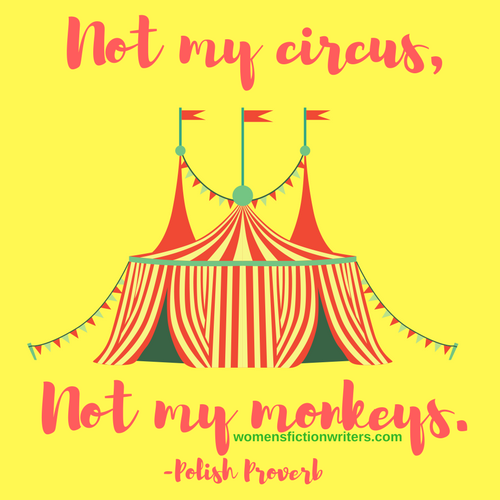
I love this saying. It seems to mean any time you feel yourself getting pulling into some mayhem not of your own making, remind yourself to step away.
But, I ask you, what happens when it IS your circus and the monkeys ARE yours?
You must step in.
The circus I’m referring to at the moment is my WIP and the monkeys are the POV and tense. Which sounds like tents. Which goes with circus and monkeys.
Oh, how I love a good theme wherever I force find one.
It might sound like an easy fix to change about fifty pages from first person present to third person past. It isn’t. It’s not simply a matter of I/she and walk/walked. Changes like this impact the way the story is viewed by the reader and by the writer. I’m no longer looking at the story through my main character’s eyes, I’m looking at it over her shoulder. You might think this distances me from the story, when in fact, it brings me closer because I have a wider lens. I made this switch with The Glass Wives, which is told from Evie’s POV in deep third. I started out in first person past, but realized that I could get more inside the story if I wasn’t in Evie’s shoes, but beside them. It also helped me, as a debut novelist, to remember that the main character wasn’t me.
Writing book four is completely different than writing book one, but the issue is the same. How best to tell the story is my main concern, especially since this story has already had a handful of starts and stops and versions, and I only have fifty pages. For the fifth time. Which is 250 pages but I hate math and we’re not counting.
As I revise and rewrite and wrangle the tense and POV, I’ve also noticed that changing these elements changes the cadence of the sentences and paragraphs. And I am a stickler for what “sounds” right to my ear.
At first I imagined it would be a mechanical exercise, one that resembled a middle-school English assignment. Lots of red marks and crossed out words. What I had forgotten was that this changes the story in some fundamental ways, and are proving to be beneficial, if not time consuming.
The wider lens is allowing me, if not forcing me, to see things that were hidden from view before.
Which is why the pages aren’t finished yet.
I’m keeping these things in mind as I revise the POV and tense and write some new scenes.
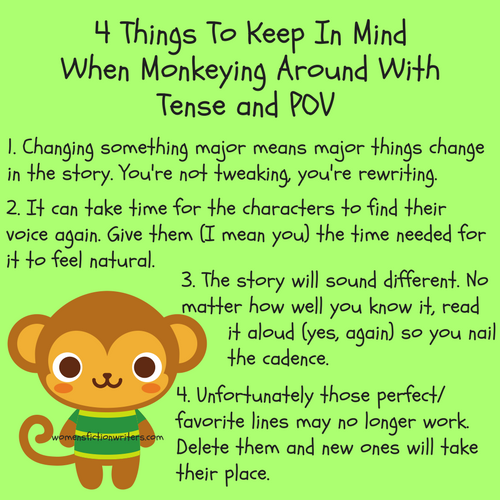
What are some of your best tips for making big changes to a WIP? Share with your fellow writers (and me) in the comments.
Amy xo
May 9, 2017
Goodreads Giveaway for Left to Chance
Here we are, seven months from publication and St. Martin’s Press surprised me with a mega-giveaway on Goodreads! The link is below!
A very few people have read it so far, and it’s been their favorite of my three novels. That’s when I tell them, it’s my favorite too. But I don’t remember if I felt that way with The Good Neighbor, so I’m just going to go with the thought that books are like children. You might have a favorite in a moment, but you love them all the same, but differently. Because each one is just as important but unique.
Left to Chance was the most challenging book I’d written up to this point, but I also had the easiest time slipping into the main character’s skin.
Considering she had no kids, had never been married, and lived in San Francisco, this might seem unlikely, but it’s true. I really “got” Teddi while I was writing her. She’s the first main character who I’ve imagined a future for. I’m not a real fan of series, but I could see another book with Teddi at some point. She’s a little older, a little wiser, and she gets herself deeper into messes. We’ll see. But for now let’s focus on Left to Chance.
Now I must remember to BREATHE. (Or it’s going to be a long seven months)
Please enter, add the book to your Goodreads shelf, and then sit back and wait to find out if you’ve won. It’s easy! And I’ll be running more giveaways soon. So hang tight. And thank you!
Amy xo
http://bit.ly/LeftToChanceGiveaway
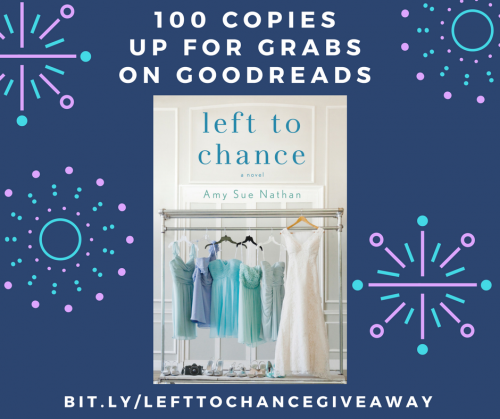
Women's Fiction Writers
- Amy Sue Nathan's profile
- 543 followers


